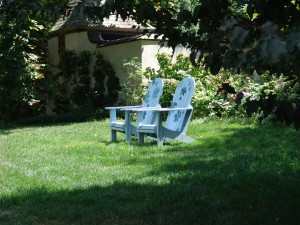
A beautiful green lawn, like this gathering space at Chanticleer Gardens in Radnor, PA, can be achieved with fall fertilization.
Spring is here (even though it doesn’t feel quite like spring). So, that means it is time to fertilize your lawn, right? Wrong. It is not necessary to fertilize your lawn in the spring. In fact, it is much better to fertilize in the fall. Grass puts its energy into growing leaves in the spring, which means more mowing. But, grass puts energy into root growth in the fall, which means healthier, more resilient plants. It is OK to add about ½ pound of nitrogen per 1000 square feet of lawn in April, which translates to 5 lbs of 10-10-10 fertilizer or 2 pounds of 25-5-10 fertilizer. Some people like to have their lawn green up more quickly or at the same time as their neighbors. This amount of nitrogen will be readily used by the lawn as long as it is not applied right before a severe rainfall. But, it is not really necessary for a healthy lawn. If you want to manage your lawn as simply as possible, apply one application of a slow release fertilizer in September, using 2 pounds of nitrogen per 1000 square feet (12 ½ pounds of 16-3-7 fertilizer). If you don’t want to use a slow release fertilizer product, you can split the application of fertilizer into two applications-one in August/September and one in October/November. If this sounds complicated, watch the videos on the livable lawns website for a simple explanation (http://www.delawarelivablelawns.org/homeowner.php).
But wait, phosphorus is also an issue in lawn fertilizer. That is the second number in the analysis (N-P-K). Many soils in Delaware already contain plenty of phosphorus and it isn’t necessary to add anymore. In fact, extra phosphorus can run off and pollute our rivers and streams. So, it is a good idea to take a soil test before you fertilize. Find out if you have enough phosphorus and if so, use a low phosphorus or phosphorus-free fertilizer on your lawn. Some neighborhoods in Delaware, where phosphorus in the soil is high, simply require phosphorus-free fertilizer.
A number of Delaware environmental agencies want to encourage you to apply the right amount of fertilizer to your lawn at the right time, as well as increase the number of native trees in Delaware’s suburban landscape, so keep your eyes open for a new Livable Lawns Program for homeowners. You can hire a certified livable lawn company to manage your lawn maintenance (see http://www.delawarelivablelawns.org/directory.php for the certified company nearest you). Or you can manage your own lawn following the livable lawns guidelines (http://www.delawarelivablelawns.org/homeowner.php). If you become a certified livable lawn, Livable Lawns will provide a $100 voucher to purchase native trees from participating retailers to plant on your property. Check the Livable Lawns website (http://www.delawarelivablelawns.org) in late April for details about this exciting new program.
Spring is also the time people apply preemergent herbicides to control crabgrass in their lawns. Crabgrass is an annual grass that germinates from seed each spring. By applying a preemergent herbicide, you set up a chemical barrier that kills newly germinated crabgrass seedlings before they emerge from the soil. The best way to prevent crabgrass is to have a thick, healthy lawn, which you can get by fertilizing in the fall. The dense lawn prevents light, needed for germination, from reaching the crabgrass seeds. If crabgrass has been a problem in the past, it may be necessary to use an herbicide this year to control the crabgrass and start your fall fertilization program in September. You do not need to buy a product that contains both fertilizer and crabgrass preventer, although that is what many lawn and garden stores sell. Look a little more closely for a product that contains just a preemergent crabgrass herbicide.
The bottom line is before you reach for that bag of fertilizer this spring, consider switching to a more sustainable lawn management program.


You have some helpful information about lawn fertilizer. It’s good to know that our lawn can handle that nitrogen, as long as it’s not right before a rainstorm. Next spring, after the snow melts, I’ll remember to try this. http://www.tandninc.com/about-us.html
Very Helpful Infomation. Thank You For Sharing This Information. Awesome!!
More information for grass in:
https://gardin.es
I just read your article on fertilizing lawns. You’re totally right! There is no need to fertilize a lawn in the springtime because we don’t have any kind of cold weather yet. In fact, fertilizer can actually cause more damage than help during this time of year.
https://www.wvlandscaping.ca/residential
I stopped by your blog and found a great article on when to fertilize your lawn. I was going to do it this spring, but now that I’ve read this article, I’m not so sure!
Thanks for the heads up. It’s great information and you’re an excellent source of knowledge. Thanks again!
https://www.nanaimo-landscaping.ca/landscaping
I read your recent post”. I really enjoyed it! I find myself wishing there were more articles like this one. Articles that show people how they can really take care of their yards and still have time for other things in life.
https://www.hedgesbc.ca/